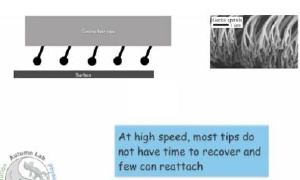Jun 4 2009
Whether it's driving on icy roads, rock climbing, or getting a better grip on a bat, the science of friction and adhesion plays a role-large and small-in many human activities. In a new research paper published in the Royal Society journal Interface, biology professor Kellar Autumn from Lewis + Clark College shows how the nano-hairs on gecko toes can reveal new insights into the fundamental nature of friction and adhesion.

Click here to watch the video
Leonardo da Vinci did the first experiments on friction, and found that most objects slip more easily as they slide faster, which makes intuitive sense. If a person's foot slips, they are likely to fall. However, Autumn and colleagues studied the nano-hairs on gecko feet and discovered that gecko hairs actually become stickier as they slide faster, and did not wear out even after sliding 300 meters.
Autumn and his research team developed a mathematical theory based on the random vibration of the gecko's nano-tips. Their theory suggested that it should be possible to fabricate a synthetic gecko-like material that also becomes stickier as it slides.
Science “first” will advance technology for host of products
In the research, funded in part by the National Science Foundation, team member Mark Cutkosky at Stanford University molded synthetic hairs 10 times larger than real gecko's hairs. The synthetic hairs became stickier as they slid, and resisted wear–a first for science. This “dynamic adhesive” has many applications, including anti-skid car tires, shoes, and sports equipment.
An interesting side-note to this study is that it provides some of the first empirical support for theories about atomic friction and earthquakes. Autumn and his coauthors suggest that geckos, atoms, and earthquakes may share common dynamics.
“By studying why geckos have the ability to stick to surfaces, the team led by Professor Autumn has made fundamental discoveries about the nature of friction and adhesion,” said John Rundle, professor of physics and geology, and an expert in earthquake simulation at the University of California-Davis. “These results may lead to advanced synthetic materials with novel and important properties, as well as providing far-reaching new insights into phenomena as disparate as earthquake faults and neural networks, both of which possess similar dynamics.”
More secrets to unearth in nature's bio-diverse geckos
With over 1,000 species of geckos, each has a unique-pattern of nano-hairs on its toes. Autumn is currently working to understand why geckos have evolved so many different designs, and how this biodiversity can be used to solve sticky engineering problems ranging from automotive assembly to micro-electrical connections.
“One big question is how the size of the hairs affects their function,” Autumn said. “Theory suggests that smaller hairs stick better, but larger structures are easier to fabricate. Fortunately, species of gecko have evolved hairs of different sizes, so it is a matter of measuring hairs from these species.”
Autumn is also working to resolve conflicting studies about the role humidity plays in adhesion and studying how rough surfaces and hairs interact.